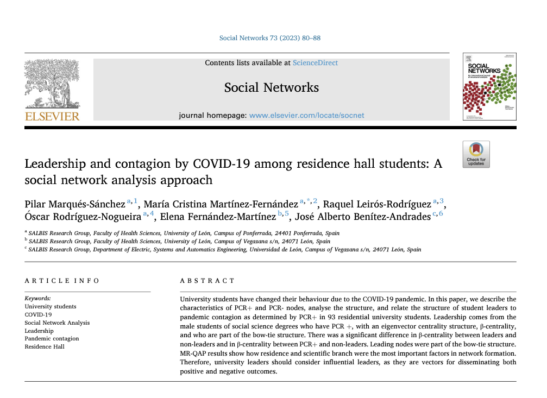Leadership and contagion by COVID-19 among residence hall students: A social network analysis approach
- a SALBIS Research Group, Faculty of Health Sciences, University of León, Campus of Ponferrada, 24401 Ponferrada, Spain
- b SALBIS Research Group, Faculty of Health Sciences, University of León, Campus of Vegazana s/n, 24071 León, Spain
- c SALBIS Research Group, Department of Electric, Systems and Automatics Engineering, Universidad de León, Campus of Vegazana s/n, 24071 León, Spain
Available online 6 January 2023, Version of Record 13 January 2023.
Highlights
- Leaders with high eigenvector and b-centrality have a PCR+ contagion score.
- The prediction of contagion is given by an influential node that is part of the Bow-tie structure in the network.
- Contagion prediction is provided by a leader node that is part of the Bow-tie structure.
Abstract
University students have changed their behaviour due to the COVID-19 pandemic. In this paper, we describe the characteristics of PCR+ and PCR- nodes, analyse the structure, and relate the structure of student leaders to pandemic contagion as determined by PCR+ in 93 residential university students. Leadership comes from the male students of social science degrees who have PCR +, with an eigenvector centrality structure, β-centrality, and who are part of the bow-tie structure. There was a significant difference in β-centrality between leaders and non-leaders and in β-centrality between PCR+ and non-leaders. Leading nodes were part of the bow-tie structure. MR-QAP results show how residence and scientific branch were the most important factors in network formation. Therefore, university leaders should consider influential leaders, as they are vectors for disseminating both positive and negative outcomes.

